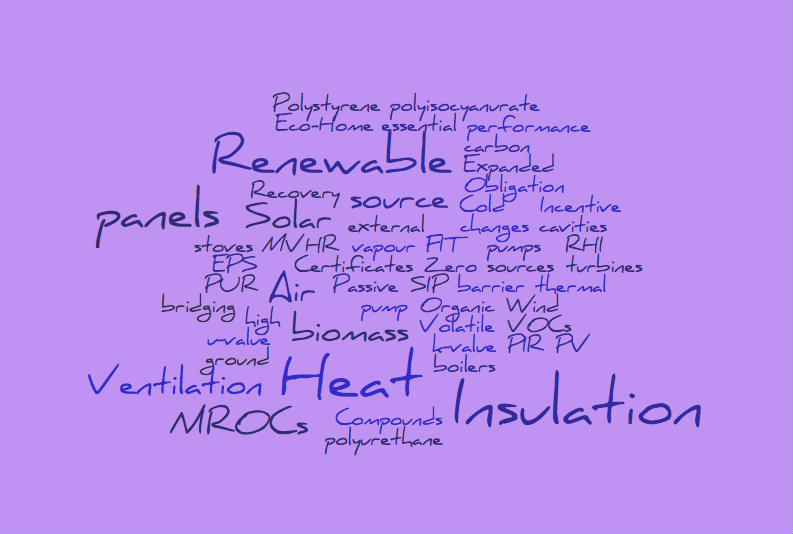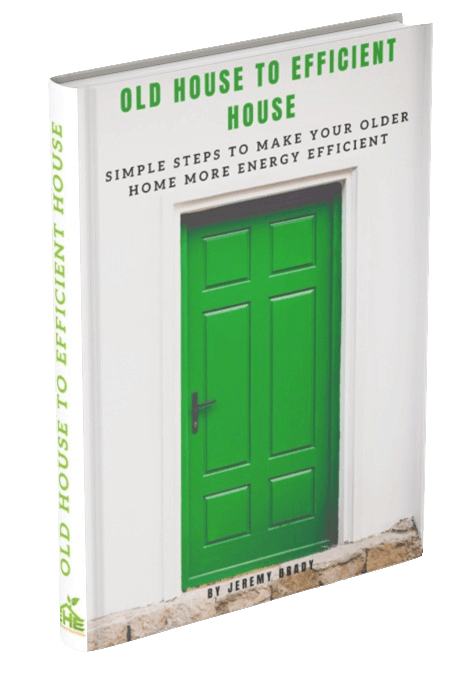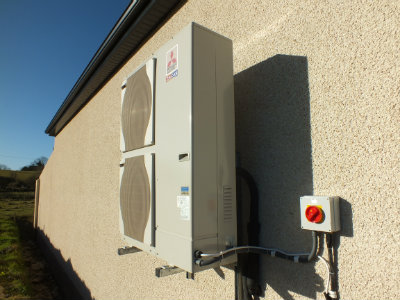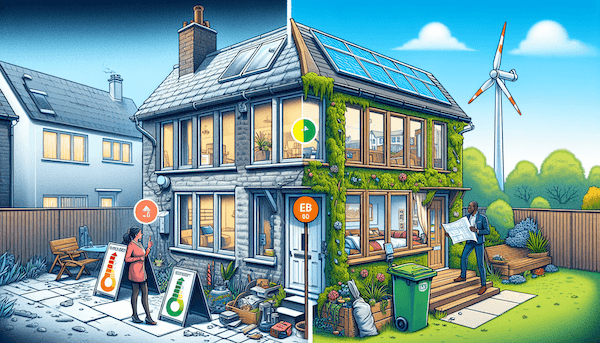- Home
- Eco Jargon Buster
Eco Friendly Jargon and Terminology Explained
Welcome to our eco friendly jargon and terminology section. Here I’ll give you a quick definition of the various eco phrases and jargon you’re likely to come across when talking to suppliers, Architects etc.
In order to try and keep this as simple as possible and make it easy to find the term that you’re looking for I’ve split them into the different sections they relate to.
General Eco Friendly Jargon and Terminology:
Heat Transfer:
U-value - this is a rating for how quickly heat transfers across a building element. So the lower the number the better that particular element is at retaining heat. U-values are measured in W/m².
K-value - this is the thermal conductivity of an element and is used to calculate the u-value. It takes into consideration two things 1. the thermal conductivity of each element and 2. how thick that element is.
R-value - This is used more in the USA but it’s probably worth covering just in case you come across it. It’s a measurement of resistance to heat transfer (the opposite to u-value), so the higher the number the better the product is at resisting heat transfer.
Construction:
Cold bridging - a cold bridge is an area where cold can get across a building element by conduction. An example would be a concrete window sill. In this case the sill goes right from outside your home to the inside without a break. Meaning it allows cold to cross from the outside to the inside.
SIP - a SIP or Structural Insulated Panel is a building element used to build the inner leaf of a wall (a bit like a timber frame but it comes pre insulated and is much stiffer). SIPs avoid cold bridging and are easy to make air tight.
House Types:
Passive - (also includes Passivhaus and passive solar house) - these types of house need little of no additional heating as they generate their own heat (from appliances and people etc.) and then recycle it to keep it in the house.
Zero Carbon - a zero carbon home or carbon neutral home is one that generates all it’s own power for heating, lighting, hot water and appliances without expelling CO₂ into the atmosphere. This can be done by using a CO₂ offsetting scheme.
Grants:
FIT - this stands for Feed in Tariff and is a payment that PV solar panel users located on the UK mainland receive for generating power from their PV panels.
NIROCs - Northern Ireland Renewable Obligation Certificates are the alternative to the Feed in Tariff above, that people in N. Ireland receive for generating power from their PV panels.
RHI - the Renewable Heat Incentive is a payment received by people who generate heat from renewable sources i.e. air and ground source heat pumps, biomass boilers, biomass stoves or solar thermal panels.
Insulation:
EPS - EPS (Expanded Polystyrene) is used in bead form for pumping into cavities, sheets for installing in cavities when building, and sheets for use on external insulation. It’s the cheapest form of insulation but also one of the poorer preforming.
PIR - this stands for polyisocyanurate and is formed into insulation by adding chemicals to a blowing agent to form tiny bubbles. The end result is a high performance insulation material. Usually sold in sheets with a silver vapour barrier stuck to the outside and is most commonly used in cavities, floors and roofs in new builds.
PUR - polyurethane is just like PIR above but uses different chemicals.
Ventilation:
Air changes - the number of times the air in your home is replaced by fresh air from outside your home. It can also be measured in litres/second or air changes per hour.
VOCs - Volatile Organic Compounds are nasty chemicals contained in many manmade items within your home. They evaporate easily at room temperature so you’re breathing them in all the time. The best known ones include Formaldehyde, Acetone and Benzene etc. They’re prevalent in carpets, glues, MDF, paints, fabrics, air fresheners and lots of other household items.
PIV - installing a PIV (Positive Input Ventilation) unit is probably one of the more popular ways of upgrading the ventilation in your home. They constantly push air into your home which forces out stale air through gaps in the fabric of your home. Read more here.
MVHR - Mechanical Ventilation with Heat Recovery (MVHR) is the gold standard of ventilation systems. They extract warm stale air from your home, during the process it removes the heat from this expelled air and then adds that heat to the fish air coming in. It’s easy to fit into a new build, but a little more difficult to install in a retrofit scenario.
Cross Ventilation - this refers to the movement of air around your home. #content_45364728 will ensure all the air in your home gets moved. Poor cross ventilation could leave you with pockets of stale air which doesn't get removed.
Solar Panels:
PV - Photovoltaic (PV) solar panels generate electricity.
Solar Thermal - solar thermal panels generate hot water.
kW/peak - this is the maximum output a PV solar panel or wind turbine is capable of producing in ideal conditions.
kW/hr - this is the actual amount of power your PV panels or turbine are actually producing.
Light Bulbs:
Warmth/Kelvins - This is what the industry uses to describe the colour of light given out by the bulb in question. See here for more details.
LED - LEDs (light emitting diodes) are actually the individual light sources found in what are commonly referred to as LED bulbs. So each “LED bulb will typically contain a group (from one to 10 or more) of individual LEDs. They light up instantly, last longer and use less energy than CFLs.
CFL - CFL’s (compact fluorescent lightbulbs) are literally mini fluorescent tubes that fit into lamps etc. There were one of the first energy efficient bulbs available.
Reports:
EPC - an Energy Performance Certificate is a legal requirement for all homes being sold or rented in the UK. It gives the new occupants an idea of the energy efficiency of the property and a rough guide to how much it will cot to provide heat and power to the property over a year. It also suggests improvements and how much they could reduce your bills by if implemented.
New Build SAP - these a bit like an EPC but are more accurate and are calculated from your plans before your home is built.
Heat Pumps:
COP (Coefficient of performance) - this is the ratio of heat provided to the energy required to produce that heat. Good heat pumps have a COP of around 4. Meaning for each kW of energy required to run the heat pump it will produce 4 kW’s of heat.
Biomass:
EN Plus - this is the european standard for wood pellets. In order to get the Renewable Heat Incentive you will need to burn EN Plus pellets in your biomass boiler or stove.
Condensation:
Dew point - this is the point at which air cannot hold any more moisture and condensation begins to form. Dew point will vary with temperature, air pressure and relative humidity. See here for more information.
Eco Friendly Jargon and Terminology Conclusion:
This is likely to be only the tip of the eco friendly jargon and terminology iceberg that you're likely to com across on your journey towards making your home more eco friendly and lower your annual bills.
I'll add to this section as and when I come across terms I think you’d like to see included. But, if you think there’s something that should be included, please let me know by contacting me here.














New! Comments
Have your say about what you just read! Leave me a comment in the box below.